On the occasion of Merve Ceylan’s forthcoming first solo exhibition in 2025 at the gallery, I’m delighted to introduce you to the artist’s artistic world in a new interview.
There is a great presence that runs through the work of Austrian painter Merve Ceylan. That of things that are there, in front of you, like this still life of pomegranates that you could almost come and pick. It’s about the presence of those with whom we’ve lived for a time, and whose memory doesn’t necessarily manage to fully define their outlines. Objects and empty spaces are the traces of those who are not physically there. Ceylan summons up her memories, the sensations she has experienced, and looks for witnesses, notably through old photos and paintings, to understand what remains despite time and also to understand the present. « When you grow up in many places as a child, a lot of things get mixed up and the photographs help me to feel my way back in. » explained Merve Ceylan. This back and forth between past and present characterises the work of the painter, whose childhood and adolescence were marked by numerous moves between Austria and Turkey, via Germany. Today the artist lives and works in Vienna.
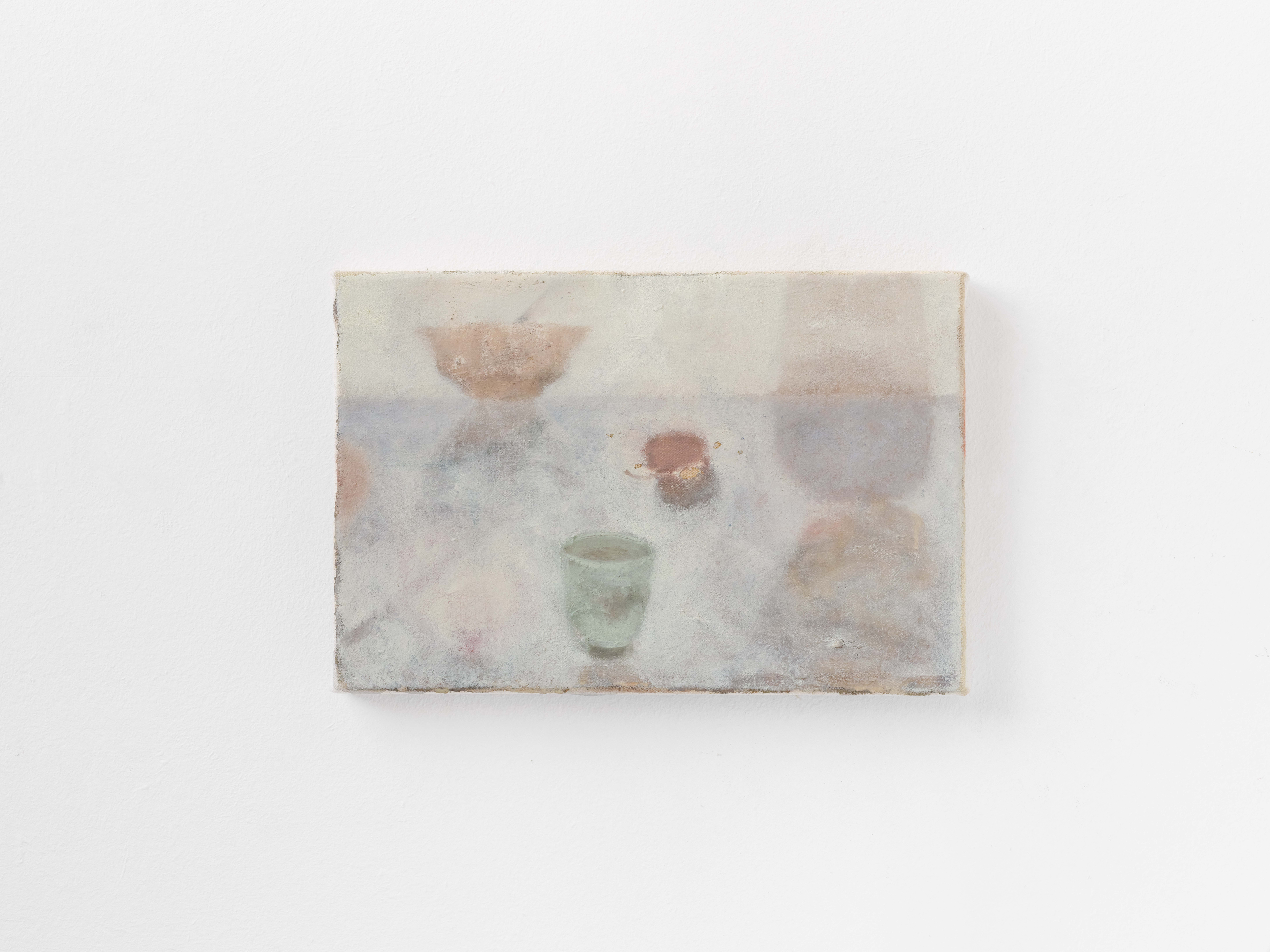
Merve Ceylan, they"ll fly away if i move, 2024, oil, pigment and clay ground on canvas, 30x20 cm ©Valerie Maltseva
" Everything is fleeting "
Merve Ceylan
Elsa Meunier : Could you introduce yourself?
Merve Ceylan : My upbringing was split between two countries. Austria for one, where in 1995 I was born in a little valley near the Limestone Alps and Türkiye, which I consider to be my culture of origin. The foundation dates back to the time my Turkish grandparents migrated to Austria in the 1980s. I come from a working-class family with my mother being a single parent early on, which might be one of the reasons that my first encounter with something related to the arts started relatively unnoticed. I was a child who carefully observed my surroundings and believed that everything had a story to tell and a life of its own. I still remember our farewells when we travelled to Türkiye to live there. At the age of seven I got to know my culture, which was already very familiar to me even from afar. I quickly got used to the situation but felt divided, as is often the case for migrants. When I was thirteen we returned to Central Europe to settle in Germany but still moved around quite a bit within national borders. It was in the later stages of adolescence that I really felt the urge to be artistically active with my inner calling being all the more present. In 2014 I started studying at the HfG in Offenbach. Between 2018 and 2019 I went abroad to study at Mimar Sinan in Istanbul, which was quite significant and shaped me in many ways. Now I’m back to my country of birth, studying and living in Vienna. Somehow I have time and again been drawn back to the places where I grew up.
E.M: You work in a variety of pictorial genres: portraits, still lifes, and genre scenes depicting uninhabited interiors. Although if the genres are varied, there is an equality of attention in the way they are represented. All these representations share a feeling of something that is there, but that seems to escape us as if you created from memories and trying to materialise what the memory keeps but which escapes us at the same time. Is that the case?
M.C: It makes me think of the stain of a glass on a wooden table, that’s how it feels. So you know that even if the glass is no longer there, it once was. With my work I try to move back and forth in order to understand, also in terms of time. Everything is fleeting. I try to paint through what moves me internally or externally without thinking much about it, walking the lines of memory. What emerges was perhaps already there, but I only begin to understand it more when it is painted. As if the fragments of dreams had become reality and as if I were to place the glass on its stain again to reassure myself. It's less about the actual representation, so it's not really about the table being a table, it's more about the feeling you had when you were or were not sitting at that table.
E.M: You often associate your paintings with photos and photos from family archives. Your origins, your family past, seem to be your main resource from which you draw your painted subjects. Your work seems to materialize a back-and-forth between past and present. Can you tell us about this research?
M.C: My personal history and cultural identity are the largest vessels from which I draw upon. The photographs I use more as guardians of the paintings, like a shepherd guiding the sheep. I like the mood and vibration of old analogue photographs. It has become a habit to look for them while travelling in order to feel and see the history of a place more clearly. These old now archived photographs always entail a moment that someone really wanted to capture since back in the day it was costly to take a picture. My family archives on the other hand seem necessary for my personal understanding of where I come from and make it more tangible. When you grow up in many places as a child, a lot of things get mixed up and the photographs help me to feel my way back in.
I take quite a lot of photographs myself and the situations and motives I choose, the way I experience the world, are inevitably reflected in my paintings. It's just the way I take in the world through my eyes and what I sense as a consequence.
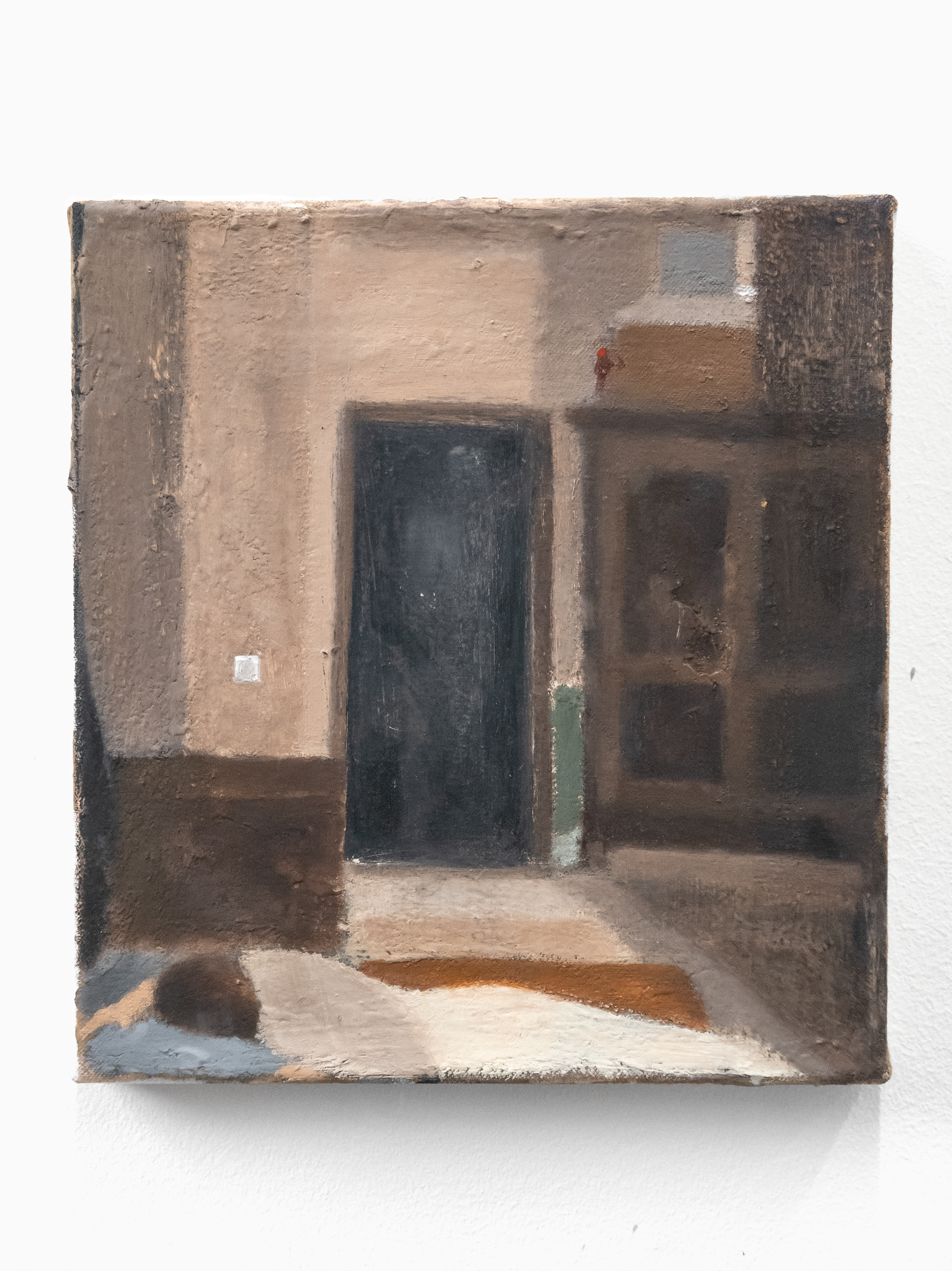
Merve Ceylan, mein koÌrper ist in einer orange und die orange ist in einer kiste, 2023, 27 x 25 cm
E.M: You paint scenes of uninhabited, silent, bare interiors. These spaces are bathed in bright, dazzling white light. It seems to indicate that these spaces are mental spaces. What do you want to capture in this work?
M.C: Every space and place has inhabitants, whether they are spiritual or physically present. Without manifestations we would not be able to experience absence in these spaces. I appreciate the moment when entering a room and certain feelings begin to appear with a story subsequently offering itself. You can of course also relate this to inner spaces. I think many people can empathise with the fact that some places seem oppressive, whereas in other places there is a sense of lightness. In the past living spaces were filled with so much attention to detail. A single chair could fill the whole room, something we seem to be missing more and more. Perhaps the longing of the past, the attention that could be paid to every howsoever small thing is also inherent in this. Unfortunately much is lost too quickly without us realising until the rooms are completely devoid of anything that lives.
EM: You paint many portraits, but the characters depicted rarely meet our eyes: their gaze is often downcast or directed toward something we can't see, an other space outside of the space of the painting. There is no direct frontal contact with the people represented. All theses portraits share a strong presence and through the colours used and also a form of distance through the way in which their attitude escapes us. Could you tell us about it?
M.C: While I'm painting the portraits I find myself in various, strange processes that I can’t really express in words. Until I reach the point of finishing the painting there is a lot going on, which can be deeply upsetting at times. I guess the way in which the paintings are ultimately in touch with the viewer and how far they open up is always different and dependent on every individual. In any case, the portraits have one thing in common and that is simply put, being vulnerable. Someone I once met said ‘our wounds speak and we connect most deeply with them’.
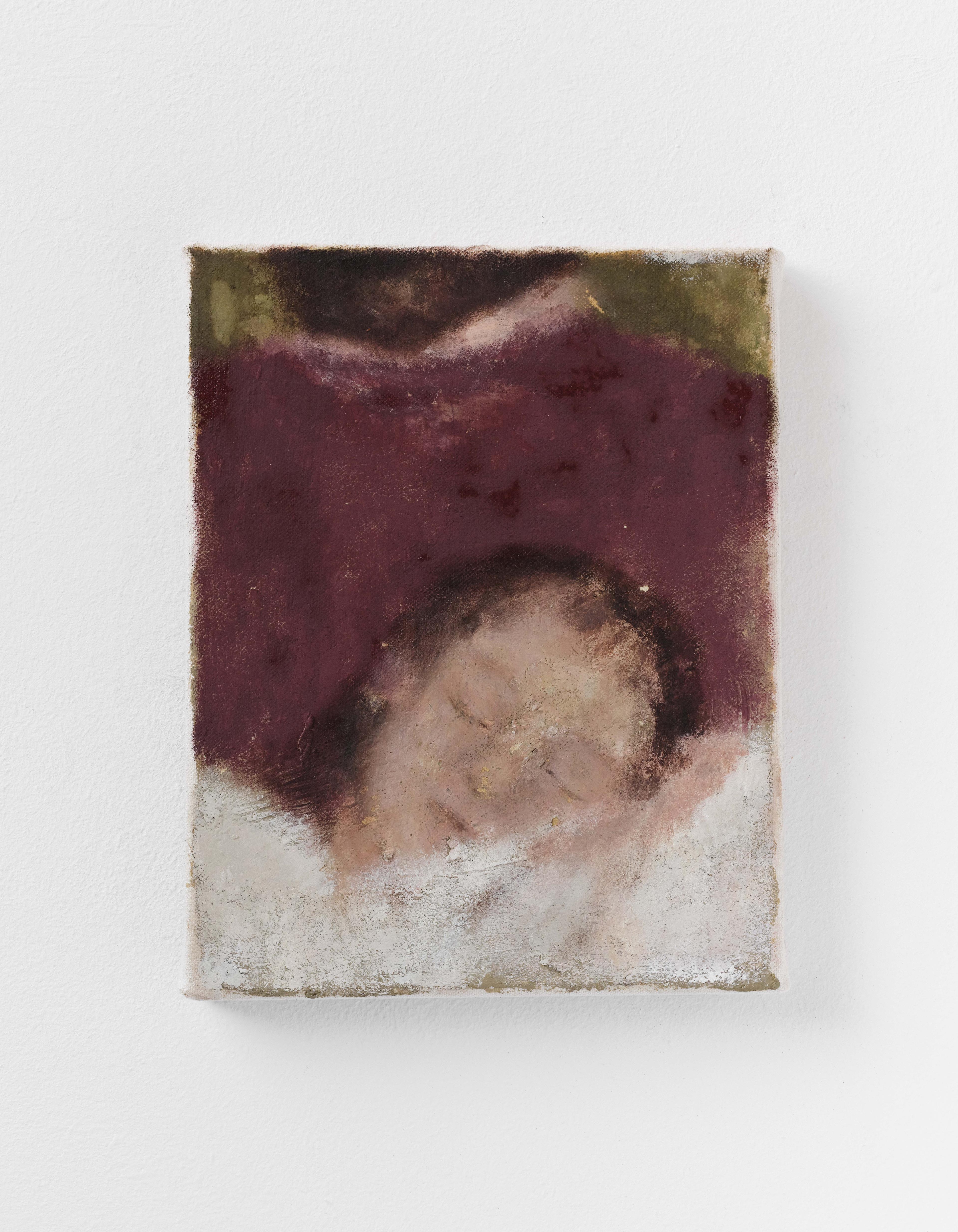
Merve Ceylan, taube blume, 2024 oil, pigment and clay ground on canvas, 19x25 cm
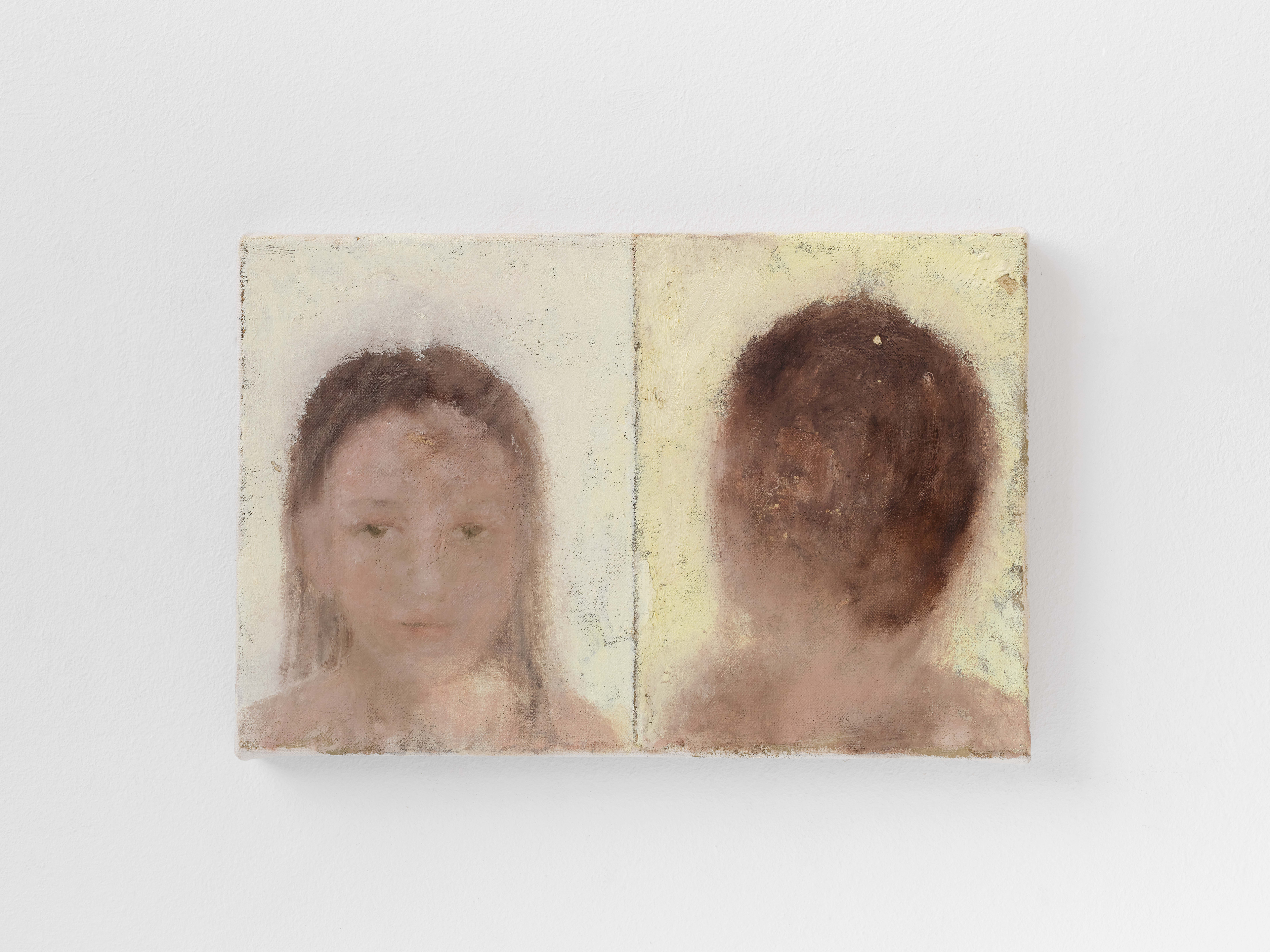
Merve Ceylan, dandelion in april (the bees die in the first flower), 2025 oil, pigment and clay ground on canvas, 35 x 23 cm
E.M: You’ve also developed a body of still life work in which space and form seem to be placed on the same plane with great colors. What are you trying to achieve in this work?
M.C: I am not trying to say anything in particular. All the paintings stand entirely for their own. In contrast to the spaces and portraits, the still lifes and especially the fruits bring something like a break, a lightness and a space to rest with the eyes. They are also a lot of fun to paint and everyone can remember the flavour of a fruit. There are such wonderful types of fruit and incredibly beautiful, rich textures and colours that nature offers us, it would be sad not to use them. From what I see still lifes seem under-appreciated as they are mostly read as plain representations, which I completely deny when I look at Morandi for example. It's fascinating to think that you can wander through so many different cultures and places by flavours and scents. Especially as food has the wonderful ability to bring us together.
E.M: Can you describe your usual artistic process for creating your paintings?
M.C: I don't have a specific process for creating all the work. Neither do I have preliminary sketches nor do I use photos as means of direct reference. I mainly revert to memories and tap my way into the formats. I suppose everything I take in and experience blends into the work in one way or the other. Many inner images open up and I seize them. Of course there are some reoccurring practices. I usually prepare a bunch of canvases all at the same time. For me this establishes the first point of contact. Next I choose a colour space that is able to hold in what I’m feeling. Sometimes something happens right away. Some other times I carry on until the fog lifts a bit, asking questions that are expressed in the paint. I have to add that I can be very dissatisfied with the work and therefore overpaint a lot. This allows layers to emerge, which can turn into something that benefits the painting but at a certain point can also lead into a trap because the canvas is no longer stable. I think all painting processes can be understood as pathways to the inner levels.
E.M: Your scenes, depicting bare, silent interiors in shades of grey and white, are reminiscent of those by the Danish master Hammershøi. Is he an influence in your work? And what are your main artistic influences on your work in general?
M.C: All the things that surround you are going to influence you in some way. It’s a tabouleh of many things. For one I enjoy being out in nature, it’s as nurturing as few things are in this world. But in the same breath I appreciate being in the presence of historical sites looking at frescoes that are slowly and steadily carried through time, leaving wonderful traces on the surface. The pale colours and textures are a world of their own. In terms of art history I feel very much at home in the Middle Ages and the Early and High Renaissance. With Lorenzo Lotto, among other masters of his time, I find the portraits to be absolute treasures that seem to never tire my eyes. Regarding the field of interior painting Hammershøi is not the only one but he sure has wonderful moods that I admire. There are many other artists that I value just as much. Some of them being Morandi, Medardo Rosso, Bonnard, Vuillard, Gwen John, Orhan Peker and Mary Potter.
Text might be a completely different medium at first sight but it has the power to evoke something like a painting in my mind that can touch me in the weight, sound and colour of the words. This includes authors like Tahar Ben Jelloun, Galal Alahmadi, Semra Ertan, Emine Sevgi Özdamar and Banana Yoshimoto. Also in the world of film, the director Abbas Kiarostami is home to moods and stories that are very close to my own experience of life, they enchant me every single time.
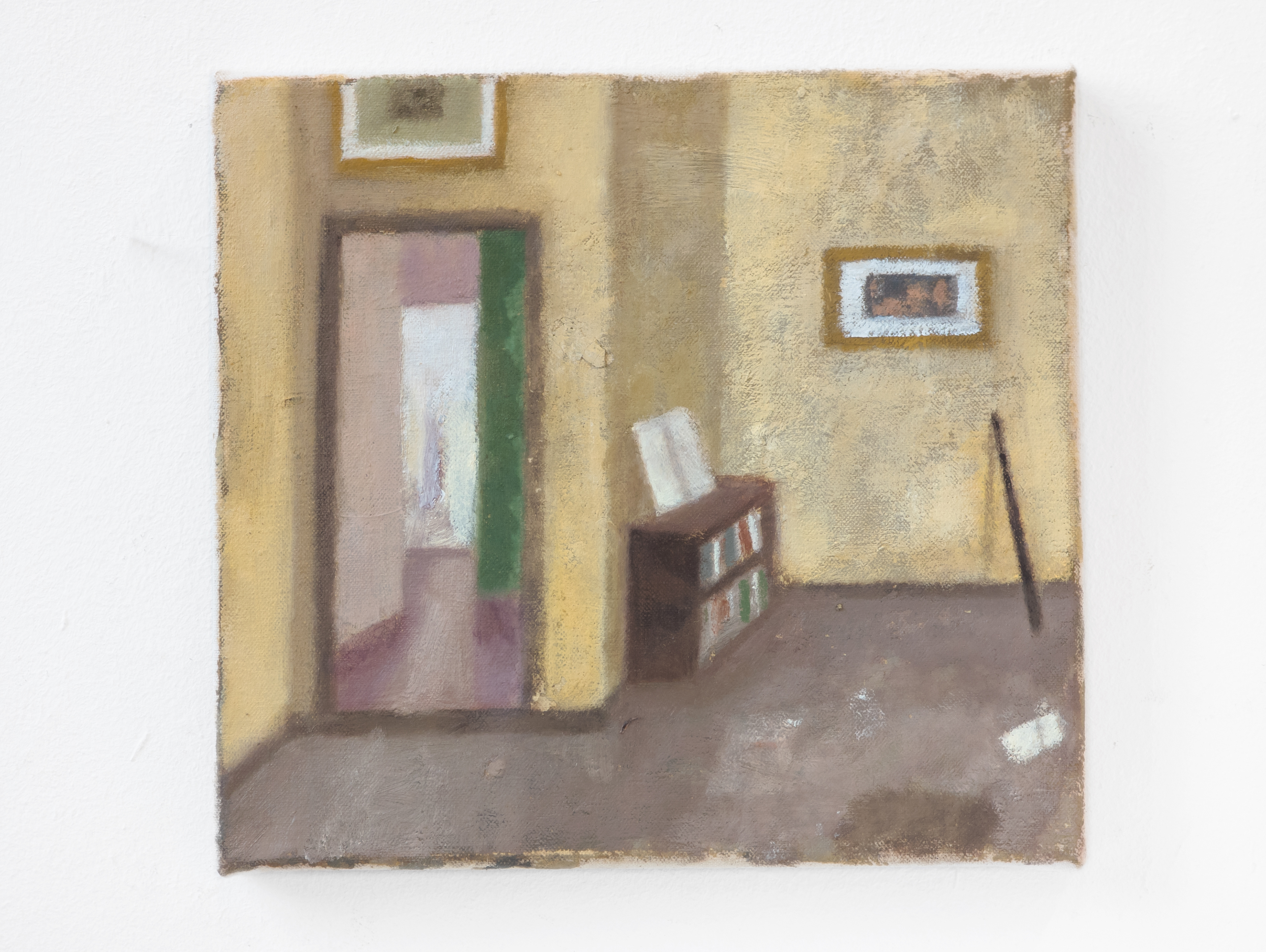
Merve Ceylan, es liegt ein schlaf auf allen dingen, 2025, oil, pigment and clay ground on canvas, 27 x 25 cm
Merve Ceylan's solo exhibition will be on view at the gallery from April 29, 2025
Galerie Elsa Meunier
15 rue Guenegaud 75006
Paris, Saint-Germain-des-près